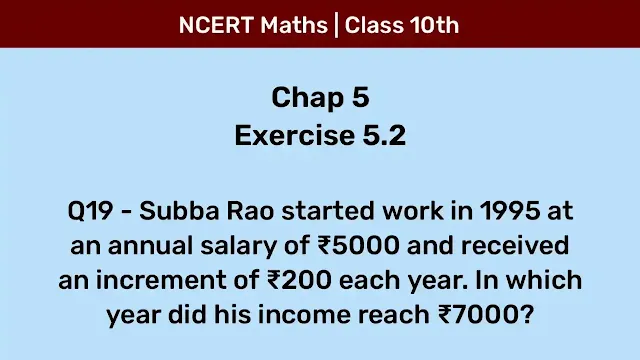Ex 5.2 Q19 - Subba Rao started work in 1995 at an annual salary of ₹5000 and received an increment of ₹200 each year. In which year did his income reach ₹7000?
Solution:-Given,
Subba Rao's annual salary in year 1995 was ₹5000.
➙ Since he received an increment of ₹200 each year,
∴ Salary in 1996 (2nd year)
= 5000 + 200
= 5200
∴ Salary in 1997 (3rd year)
= 5200 + 200
= 5400
∴ Annual salary received by Subba Rao in year 1995, 1996, 1997 was...
5000, 5200, 5400...
*Clearly, this forms an AP with
a = 5000 d = 200
Let,
Subba Rao's annual salary reached to ₹7000 in nth year,
∴ aₙ = 7000
*Using formula, aₙ = a + (n - 1)d
∴ a + (n - 1)d = 7000
∴ 5000 + (n - 1)200 = 7000
∴ 5000 + 200n - 200 = 7000
∴ 200n = 7000 - 5000 + 200
∴ 200n = 2200
∴ n =
2200
/
200
∴ n = 11
Therefore, Subba Rao received ₹7000 in 11th year's annual salary.
*Finding 11th year
1st year = 1995
2nd year = 1996 { 1995 + 1 }
3rd year = 1997 { 1995 + 2 }
.
.
11th year = 1995 + 10
= 2005
Hence,
Subba Rao's income reached ₹7000 in the year 2005.
------------------------------------
Try This..
✒ An employee’s salary in the first year is ₹8000, and it increases by ₹500 every year. After how many years will it become ₹13000?
✒ The first term of an AP is 200 and the common difference is ₹100. Find the year when it reaches ₹1000.
✒ A person starts saving ₹100 per month, increasing it by ₹50 each month. In which month will the saving be ₹1000?
❌ Common Mistakes
Forgetting that the first year is included:▸ The nth term means "after n terms," but we need to account for the starting year when converting to calendar years.Misplacing the formula:▸ Always start with aₙ = a + (n - 1)d, not aₙ = a + nd.Arithmetic errors:▸ Small calculation mistakes can lead to wrong answers.▸ Double-check your subtraction and division steps.
📝 Related Questions:-
- Ex 5.2 Q16 - Determine the AP whose third term is 16 and the 7th term exceeds the 5th term by 12.
- Ex 5.2 Q17 - Find the 20th term from the last term of the AP: 3, 8, 13, ... , 253.
- Ex 5.2 Q18 - The sum of the 4th and 8th terms of an AP is 24 and the sum of the 6th and 10th terms is 44. Find the first three terms of the AP.
- Ex 5.2 Q20 - Ramkali saved ₹5 in the first week of a year and then increased her weekly savings by ₹1.75. If in the nth week, her weekly savings become ₹20.75, find n.
Queries Solved:-
Class 10 Ex 5.2
Ex 5.2 Q19 Class 10
Class 10 Ex 5.2 Q19
Class 10 Chap 5 Ex 5.2 Q19
Class 10 Arithmetic Progression
If you found it helpful, please leave a comment below sharing your thoughts or questions.
Don’t forget to share it with your classmates to help them learn too.
Good luck, and happy learning!
Together, let’s make math simpler and more enjoyable for everyone!

